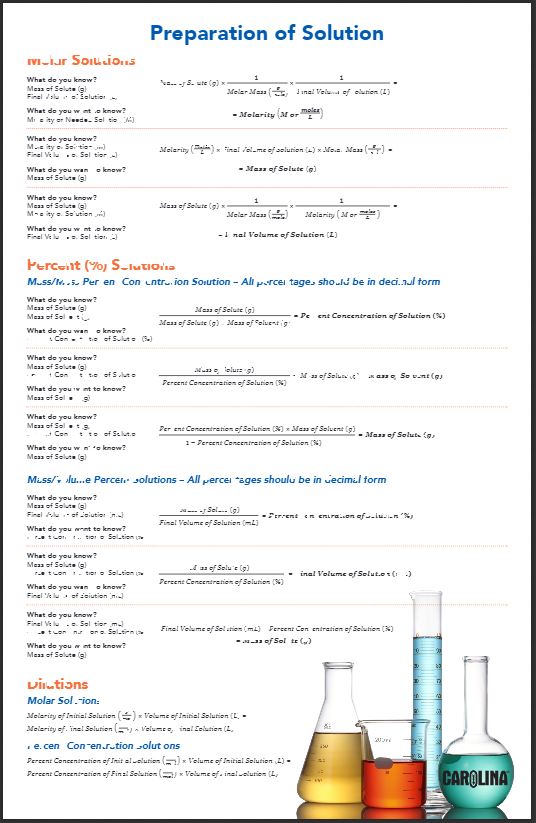Carolina offers many types of premade solutions, but some teachers prefer to make their own. If that is your interest, keep reading. This brief guide will provide you with the information you need to make a number of solutions commonly used in educational laboratories.
Let’s review some safety considerations:
- To make a 1 M solution of sodium hydroxide, slowly add 40 g sodium hydroxide to 500 mL distilled or deionized water in a 1-L volumetric flask. When the solids are completely dissolved and the solution is at room temperature, dilute to the mark, insert and secure the stopper with your thumb, and invert the flask several times to mix.
- To make a 1 M solution of acetic acid, dissolve 60.05 g acetic acid in 500 mL distilled or deionized water in a 1-L volumetric flask. Because acetic acid is a liquid, the acid may also be measured by volume. Divide the mass of acid by its density (1.049 g/mL) to determine the volume (57.24 mL). Use either 60.05 g or 57.24 mL acetic acid to make the solution. Swirl the flask gently to mix the solution. When the solution is at room temperature, dilute to the mark, insert and secure the stopper with your thumb, and invert the flask several times to mix.
Dilutions
When preparing a dilution, decide the volume and molar concentration of the resulting solution you require. Use the following equation to determine how much of the concentrated reagent is needed to prepare the diluted solution,
Mreagent × Vreagent = Mdilution × Vdilution
where M is molarity and V is volume.
Slowly add the calculated volume of concentrated reagent to the proper-size volumetric flask half filled with distilled or deionized water and swirl the flask to mix. Once the solution is at room temperature, dilute to the mark with water, insert and secure the stopper, and invert the flask several times to mix.
For example, what volume of 10 M acetic acid is required to prepare 1.0 L of 0.50 M acetic acid?
10 M × Vreagent = 0.50 M × 1.0 L
Vreagent = 0.050 L = 50 mL
A volume of 50 mL of 10 M acetic acid is required to prepare 1.0 L of 0.50 M acetic acid.
Recipes for common solutions
To prepare these solutions, slowly add the necessary ingredients to a 1-L volumetric flask half filled with distilled or deionized water. Allow the ingredients to dissolve completely, swirling the flask gently if necessary. Once the solute is completely dissolved and the solution is at room temperature, dilute to the mark with water. Insert and secure the stopper and invert the flask several times to mix.
Each reagent in the following chart is linked to our online catalog for additional information and convenient purchase. For the liquids, we have referenced the 500-mL size of the reagent- or ACS-grade chemical packaged in a plastic-coated safety bottle. For sodium hydroxide, we have listed the 500-g size of the reagent-grade chemical. Other sizes and grades may be available. Please consult our catalogs for more information.
| Initial Reagent | Quantity to add to water to make 1 L | Final Concentration |
|---|---|---|
| Acetic acid, glacial (17.4 M) | 5.7 mL acetic acid | 0.1 M |
| 57 mL acetic acid | 1 M |
|
| Hydrochloric acid (12.1 M) | 8.3 mL hydrochloric acid | 0.1 M |
| 83 mL hydrochloric acid | 1 M |
|
| 248 mL hydrochloric acid | 3 M | |
| 496 mL hydrochloric acid | 6 M |
|
| Sodium hydroxide | 4 g sodium hydroxide | 0.1 M |
| 40 g sodium hydroxide | 1 M |
|
| Sulfuric acid (18.1 M) | 56 mL sulfuric acid | 1 M |
| 5.6 mL sulfuric acid | 0.1 M |
Whether you decide to make your own solutions or buy them from us premade, you’ll find everything you need at Carolina.
- Always wear appropriate personal protective equipment (PPE) when handling chemicals and preparing solutions. Use this guide to choose the PPE that is right for your needs.
- Read a chemical’s label twice before use. Read it when you take the chemical off the shelf and again before you remove any chemical from the bottle.
- When using concentrated chemicals to prepare solutions, be sure you slowly add the more concentrated solution to the less concentrated one. The reverse procedure can cause the solution to boil and spatter.






1 Comment
Lovely